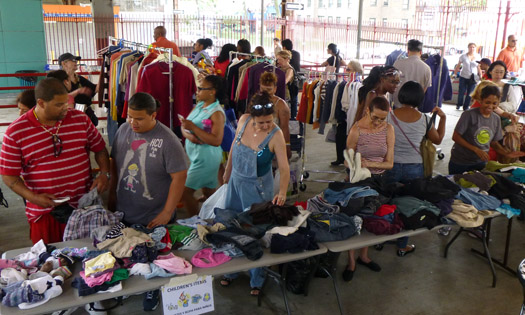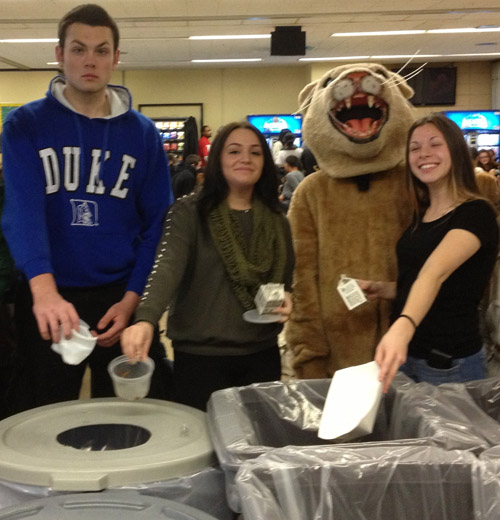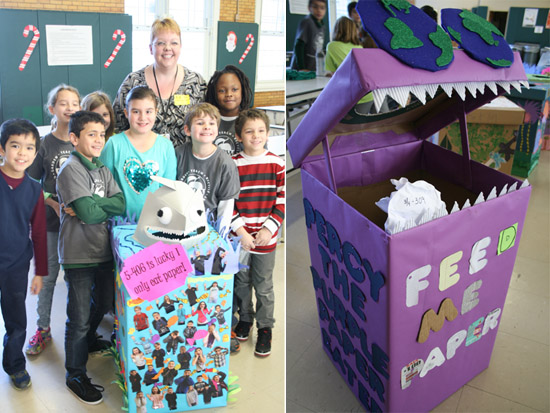




Since 2007, GrowNYC’s Office of Recycling Outreach and Education has been hosting community swap events to reduce waste and engage residents in the practice of reuse. Stop ‘N’ Swap® helps keep good things out of the landfill by bringing together people with good things they no longer need and those who can use those items. We have held 47 swaps so far, serving nearly 12,000 New Yorkers. With the addition of two new staff dedicated to our Stop ‘N’ Swap program, we aim to dramatically increase access to these events. Meet TK Zellers and Carl-Harry Nau, the team working to bring a swap to each of the city’s 59 Community Districts each year.
What’s your favorite part of the job?
CHN: At a Stop ‘N’ Swap you have a diverse group of people show up all looking for something new to add to their life. Interacting with the folks at the swap is fun because you get a sense of who they are and why they are here, and I get to see cool new stuff.
TKZ: Telling people who’ve never heard of Stop ‘N’ Swaps about what they are and what we do. There’s always a moment of disbelief, and it sometimes takes some convincing to get people to believe that, for instance, ‘it’s totally free!’, but in the end everyone I talk to is impressed, happy, and excited to get swapping! I’ve even got some high-fives, and one hug so far.
Have you always been inclined to reuse things?
CHN: I grew up in a house with two brothers and both my parents working their tails off to pay rent. So it was safe to say things like clothes, cell phones, video games, and toys were passed down from one child to the next. I even took some items that my friends no longer wanted. Reusing is second nature.
TKZ: I always liked the idea of repurposing things for more creative uses. Every gift I gave anyone until about the age of 16 was handmade out of old papers, cans, bottles and duct tape. My artistic talent didn’t ever live up to my aspirations, but it’s the thought that counts, and ugly or not, that soda-can-picture-frame stayed out of the waste stream!
What are some of the reactions you get when bringing a swap to a community for the first time?
CHN: People usually ask whether we’ll be back the next week, or when we will return to the neighborhood. Swaps receive a warm reception from those who grasp the concept of what we do and they also conjure feelings of regret by those who pass by and realize what they missed out on.
Does the swap change from neighborhood to neighborhood, or is it relatively consistent?
CHN: I have noticed the items that are swapped change from location to location. Some areas have more books, others have more house wares, and some areas have more children’s clothing.
The Stop ‘N’ Swap volunteers are pretty incredible. What keeps them going? Do you stretch before the event?
CHN: I want to say we have a great staff that works alongside the volunteers at each event. The staff leads by example and takes an “All Hands On Deck” approach during all aspects of the event. We also care for the opinions and concerns of our volunteers and take care to assign them to appropriate tasks. I will say stretching is not a bad idea!
TKZ: We haven’t come up with a Stop ‘N’ Swap calisthenics warm-up routine yet, but we do make sure to supply everyone with plenty of food and coffee before and after. I think a big motivator is how much fun Swaps can be. You never know what you’re going to find at the sorting table, and impromptu fashion shows and ‘what-is-this’ guessing games are common. Everyone manages to have a good time while helping hundreds of people find a new home for thousands of pounds of good, reusable stuff.
What is one of your favorite swap moments?
CHN: At our Upper West Side swap I spoke with a woman who came to gather items for her friends at a nursing home. She said that she had the ability to leave the facility and she knew that the others would have relished the opportunity to attend. Later I was asked by someone from the neighborhood what items people like to take at swaps and I told her sometimes people come looking for items to help others, such as the woman from the nursing home. At that point I created a connection between them and the lady who lived in the area left and returned with 6 new walkers, which went back to the residents of the nursing home.
What do you hope people take away from the experience?
CHN: I hope they understand that everything they own has value, and even though they may no longer need the item that someone else can use it. I hope the joy people get from the items they find encourages them to continue to participate and bring their unwanted items so that they can have a second life.
TKZ: Besides a few pounds of reused items, I hope people leave Stop ‘N’ Swaps with a newfound respect for reuse, and a curiosity to find out more about using and wasting less. There are so many resources to help people figure out ways to repurpose, repair, recycle or reuse anything we might otherwise just waste. GrowNYC and Stop ‘N’ Swaps are a great place to start!







 clothing, shoes and towels are collected and later sorted for reuse, or recycled into new products such as wiping rags and insulation. We quickly discovered New Yorkers’ dedication to living sustainably and have met their demand for more recycling--36 Greenmarkets now offer this service, with 10 new locations starting up this spring and summer.
clothing, shoes and towels are collected and later sorted for reuse, or recycled into new products such as wiping rags and insulation. We quickly discovered New Yorkers’ dedication to living sustainably and have met their demand for more recycling--36 Greenmarkets now offer this service, with 10 new locations starting up this spring and summer. 





























